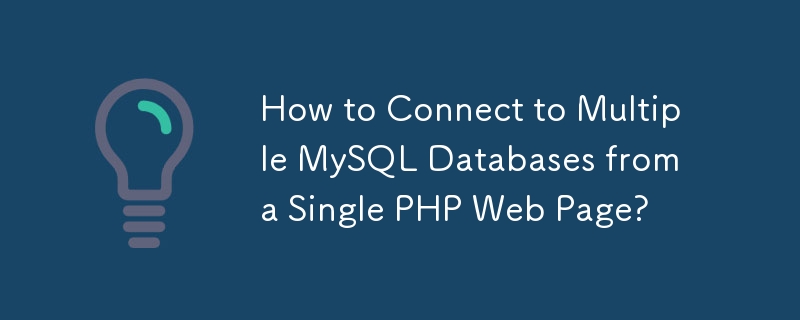How to Connect to Multiple MySQL Databases from a Single PHP Web Page?

How to Connect to Multiple MySQL Databases on a Single Web Page Using PHP
To access information from multiple MySQL databases on a PHP webpage, you can utilize multiple connections. Previously, the mysql_connect() function was used for database connection, but it's now deprecated.
Method 1: Using Multiple MySQL Connections
You can create multiple MySQL connections using the mysql_connect() function with the $new_link parameter set to true to open a new connection for each database. For example:
$dbh1 = mysql_connect($hostname, $username, $password);
$dbh2 = mysql_connect($hostname, $username, $password, true);
mysql_select_db('database1', $dbh1);
mysql_select_db('database2', $dbh2);To query each database, pass the appropriate connection identifier along with the query. For example:
mysql_query('select * from tablename', $dbh1); // Query database1
mysql_query('select * from tablename', $dbh2); // Query database2Alternatively, if you don't specify a connection identifier, the last opened connection will be used.
Method 2: Using PDO (Preferred Method)
Instead of using the deprecated mysql functions, it's recommended to use PDO (PHP Data Objects) for database connectivity. With PDO, you can establish multiple connections using different options:
a. Separate Connections:
$db1 = new PDO('mysql:host=localhost;dbname=database1', 'username', 'password');
$db2 = new PDO('mysql:host=localhost;dbname=database2', 'username', 'password');b. Shared Connection:
If the user has access to both databases through the same connection, you can specify the database in the query:
$db = new PDO('mysql:host=localhost;', 'username', 'password');
$db->query('SELECT * FROM database1.table_name'); // Query database1
$db->query('SELECT * FROM database2.table_name'); // Query database2These approaches allow you to access and manage data from multiple MySQL databases within the same PHP webpage.
The above is the detailed content of How to Connect to Multiple MySQL Databases from a Single PHP Web Page?. For more information, please follow other related articles on the PHP Chinese website!

Hot AI Tools

Undresser.AI Undress
AI-powered app for creating realistic nude photos

AI Clothes Remover
Online AI tool for removing clothes from photos.

Undress AI Tool
Undress images for free

Clothoff.io
AI clothes remover

AI Hentai Generator
Generate AI Hentai for free.

Hot Article

Hot Tools

Notepad++7.3.1
Easy-to-use and free code editor

SublimeText3 Chinese version
Chinese version, very easy to use

Zend Studio 13.0.1
Powerful PHP integrated development environment

Dreamweaver CS6
Visual web development tools

SublimeText3 Mac version
God-level code editing software (SublimeText3)

Hot Topics
 1378
1378
 52
52
 How do you alter a table in MySQL using the ALTER TABLE statement?
Mar 19, 2025 pm 03:51 PM
How do you alter a table in MySQL using the ALTER TABLE statement?
Mar 19, 2025 pm 03:51 PM
The article discusses using MySQL's ALTER TABLE statement to modify tables, including adding/dropping columns, renaming tables/columns, and changing column data types.
 Explain InnoDB Full-Text Search capabilities.
Apr 02, 2025 pm 06:09 PM
Explain InnoDB Full-Text Search capabilities.
Apr 02, 2025 pm 06:09 PM
InnoDB's full-text search capabilities are very powerful, which can significantly improve database query efficiency and ability to process large amounts of text data. 1) InnoDB implements full-text search through inverted indexing, supporting basic and advanced search queries. 2) Use MATCH and AGAINST keywords to search, support Boolean mode and phrase search. 3) Optimization methods include using word segmentation technology, periodic rebuilding of indexes and adjusting cache size to improve performance and accuracy.
 How do I configure SSL/TLS encryption for MySQL connections?
Mar 18, 2025 pm 12:01 PM
How do I configure SSL/TLS encryption for MySQL connections?
Mar 18, 2025 pm 12:01 PM
Article discusses configuring SSL/TLS encryption for MySQL, including certificate generation and verification. Main issue is using self-signed certificates' security implications.[Character count: 159]
 What are some popular MySQL GUI tools (e.g., MySQL Workbench, phpMyAdmin)?
Mar 21, 2025 pm 06:28 PM
What are some popular MySQL GUI tools (e.g., MySQL Workbench, phpMyAdmin)?
Mar 21, 2025 pm 06:28 PM
Article discusses popular MySQL GUI tools like MySQL Workbench and phpMyAdmin, comparing their features and suitability for beginners and advanced users.[159 characters]
 How do you handle large datasets in MySQL?
Mar 21, 2025 pm 12:15 PM
How do you handle large datasets in MySQL?
Mar 21, 2025 pm 12:15 PM
Article discusses strategies for handling large datasets in MySQL, including partitioning, sharding, indexing, and query optimization.
 Difference between clustered index and non-clustered index (secondary index) in InnoDB.
Apr 02, 2025 pm 06:25 PM
Difference between clustered index and non-clustered index (secondary index) in InnoDB.
Apr 02, 2025 pm 06:25 PM
The difference between clustered index and non-clustered index is: 1. Clustered index stores data rows in the index structure, which is suitable for querying by primary key and range. 2. The non-clustered index stores index key values and pointers to data rows, and is suitable for non-primary key column queries.
 How do you drop a table in MySQL using the DROP TABLE statement?
Mar 19, 2025 pm 03:52 PM
How do you drop a table in MySQL using the DROP TABLE statement?
Mar 19, 2025 pm 03:52 PM
The article discusses dropping tables in MySQL using the DROP TABLE statement, emphasizing precautions and risks. It highlights that the action is irreversible without backups, detailing recovery methods and potential production environment hazards.
 How do you create indexes on JSON columns?
Mar 21, 2025 pm 12:13 PM
How do you create indexes on JSON columns?
Mar 21, 2025 pm 12:13 PM
The article discusses creating indexes on JSON columns in various databases like PostgreSQL, MySQL, and MongoDB to enhance query performance. It explains the syntax and benefits of indexing specific JSON paths, and lists supported database systems.




